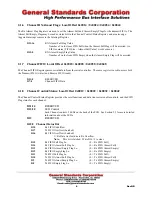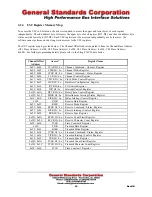
22
Rev NR
On-Board
Programmable
Oscillator
ProgClk
TxC Source
Pin Source Reg
D8:D6
IO
Connector
TxC
RxC
RxC
USC TxC
Source
Pin Source Reg
D2:D0
USC RxC
Source
Pin Source Reg
D5:D3
RxC
FPGA CLOCK CONTROL
USC TxC
USC RxC
USC TxC
USC RxC
RxAuxC
RxAuxC
USC
RxAuxC /
TxAuxC
TxAuxC Source
Pin Source Reg
D18:D17
ProgClk
TxAuxC
Figure 3-1 – Clock Configuration
The programmable clocks on the SIO8BX2 provide flexibility to handle almost any clock configuration scenario.
However, this flexibility can also complicate the clock setup, especially for simple setups. The following guidelines
are typical asynchronous and synchronous setups which should work for most setups.
In asynchronous mode, the clock does not need to be transmitted with the data. Therefore, the USC Clock pins will
be used for the input baud rate clock. Since the RxC and TxC pins have identical functions, the RxC and TxC pins
may be used interchangeably. The async baud rate clock will be 16x / 32x / or 64x the actual baud rate due to the
async oversampling. This oversample rate is set in the USC Channel Mode Register when async mode is selected.
The simplest method will be to program the channel programmable clock to be 16/32/64 times the desired baudrate
and use this clock as the source for the TxC/RxC pin. Section 2.1.11 describes how to program the Pin Source
Register to set TxC / RxC = Programmable Clock. The USC should be programmed such that TxC / RxC is an input
(in the USC I/O Control Register), and the USC baudrate generator will be bypassed completely. If both Rx and Tx
are operating at the same baud rate, the same USC clock pin can be used for both the transmit and receive clocks.
For synchronous modes, the clock is transmitted and received on the cable along with the data. This can present a
problem since the USC only has two clock pins. Since one clock is necessary for receive clock and the other is
necessary for the transmit clock, there is no clock pin available for an input to the USC baud rate generators. The
on-board programmable clocks provide a solution for this situation. By using the programmable oscillator and the
programmable clock post-divider, the on-board programmable clock can usually be set directly to the desired
transmit baud rate. The USC TxC pin and the Cable TxC are both set equal to the Programmable Clock in the Pin
Source Register. The USC RxC pin is used for the receive clock from the cable interface, so it will be set to the
















































